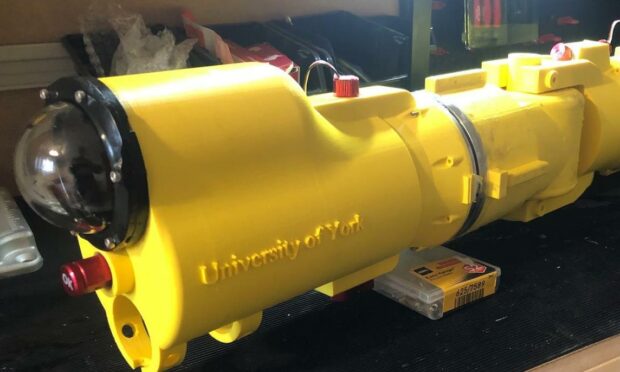It may sound like a sci-fi creature of the deep but RoboFish is no fantasy and may be swimming around North Sea energy installations in the not-too-distant future.
The agile autonomous underwater robot moves like a fish.
It is made up of several self-contained modules designed for full-body, autonomous movement around underwater structures.
The aquatic device is being developed to carry out offshore infrastructure inspections in particularly harsh and hard-to-reach environments.
Cross-border collaboration
Researchers at Strathclyde and York universities created it with grant support from the Engineering and Physical Sciences Research Council’s Supergen Offshore Renewable Energy Hub.
The research partnership has since expanded to include Aberdeen-based energy management and storage technology company Verlume, previously known as EC-OG.
Other partners include Edinburgh-based underwater robotics company PicSea and the Offshore Renewable Energy Catapult.
Verlume, which has been at the heart of energy transition projects since Richard Knox and Rob Cowman launched the business in 2013, is working on a smart power system and integrated intelligent battery management technology for RoboFish.
RoboFish revolution
The aim is to deliver reliable, uninterrupted power for the machine to operate on the seabed, including in harsh underwater environments.
Paul Slorach, business development director, Verlume, said: “With an increasing focus on decarbonisation and the automation of high-risk underwater tasks in the so-called blue economy, RoboFish is an example of how these operations can be revolutionised.
“We are pleased to act as the industry gateway for our academic partners in this project and share our expertise to integrate Verlume’s intelligent battery system as the power solution for RoboFish.”
The inspection of underwater structures can often be complex, expensive and reliant on human input.
Remotely-operated vehicles and some larger autonomous underwater vehicles can’t reach everywhere.
And as the number of structures in the sea ramps up amid rapid growth in the offshore wind sector, there will inevitably be an increase in demand for underwater inspections.
These will need to become less reliant on human input and more cost-effective, compared with traditional methods, Verlume said.
The first RoboFish prototype was completed in summer 2020, and research to improve it and apply it to new applications is ongoing.
🌊🐟News: Verlume and consortium partners progress development of robotic fish designed to enable efficient offshore inspection regimes.
Read the full press release here: https://t.co/aAeGYcqiqX@UniOfYork @UniStrathclyde @SupergenORE @PicSeaRobotics @ORECatapult pic.twitter.com/qJX8zqGBzi
— Verlume (@verlume_world) March 17, 2022
Two conference papers and a journal paper on the project have already been published.
Another journal paper is due to be published later this year, and it will focus on control of the device’s swimming gait as well as machine learning.
York University electronic engineering lecturer Mark Post said: “Through the use of innovative electronics, actuation, networking technology and additive manufacturing techniques, we have been able to develop a modular robot that can move very precisely in challenging offshore environments.
“The collaborative contributions of many partners have been instrumental in creating a practical platform to further develop robotic technologies in this field.”

